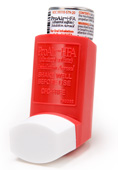Exploring the possibilities for innovation in the field of medicine and beyond.
Tuesday, February 7, 2012
The Age of Distribution: Social media in healthcare
Looking at these two asthma medications, it's not surprising that patients often confuse them. As Lawrence Martin, MD points out in 10 Common Misconceptions and Errors in Treating Asthma, when a patient becomes acutely short of breath, only the inhaler on the left will help, even though he or she will likely also own a maintenance inhaler like the one on the right.
This highlights a key distinction that's worth examining- the difference between knowledge acquisition and knowledge distribution in medicine.
Traditionally, great emphasis has been placed on the former. It's the stuff of eminent teachers and researchers, pathbreakers and groundbreakers. It's taught in hallowed halls and gathered by multimillion dollar machines.
Knowledge distribution, on the other hand, gets little fanfare. It has seen almost no growth since doctors stopped doing home visits. Patients come to a clinic, sit in a waiting room, and eventually get a few minutes to talk with their doctor to hear about the knowledge that's been gathered, and what to do about it.
This model works fine for some conditions, especially those with a quick, immediate fix. But for the majority of chronic, and costly, conditions, the information distribution element is crucial. Patients will live with these ailments daily, requiring significant understanding and by-in to their treatment. And while we often have great therapies, roughly half of all prescriptions go unfilled. This is one reason why a 15 minute office visit doesn't cut it.
All this is about to change.
We are entering a new era, where sophisticated communication tools are at our fingertips. With a smartphone and some clever apps, suddenly we aren't beholden to an office visit. Instead, doctors can get their message out to patients early and often. Those with asthma can be in continual contact with their physician, dialing in treatment to meet the evolving nature of this condition, rather than relying on a few visits yearly.
As chronic disease burdens mount, perhaps the focus will begin to shift away from knowledge acquisition and we will start to develop means of keeping more continual, low-level contact with these patients the gently nudge them towards optimized health. Perhaps medical school curricula will embrace social media and mobile apps, and a new wave of doctors will be able not only to acquire knowledge, but to also push it to where it counts.
Subscribe to:
Post Comments (Atom)


7 comments:
Great post! It would be interesting to see your thoughts on what the "house call" means today in the age of distributed, interactive media?
ingicaliThanks Aaron.
First of all I'm shocked that these two inhalers are so similar. Nearly always short acting bronchodilators are coloured blue in the UK. I don't think it is informatiom to patients in this case that needs to change, it's better design.
Next, we have been making quite good progress on knowledge disemmination in the UK. We have some great, independent sources for health professionals such as Prodigy which pull together guidelines and reviews.
http://prodigy.clarity.co.uk/home
And other initiatives such as Map of Medicine http://www.mapofmedicine.com/ and NICE pathways http://pathways.nice.org.uk/ which are aimed at both but probably more useful to health professionals. And finally there are the great patient-directed resources of NHS Choices http://www.nhs.uk/Pages/HomePage.aspx
But still it takes more than just information to lead to behaviour change... that's where the challenge lies:)
Mike- yeah, the house call. I still think it's a waste to move a body around when shuffling information will do. A waste, that is, until all that the patient needs is companionship.
Anne Marie- thanks for those resources. I really meant knowledge instead of information, in the sense that patients need the knowledge/wisdom/motivation to optimize behavior, from inhalers to lifestyle. Thanks again for commenting!
As an aged customer do you think patients use 'long' words like 'optimise','interactive','motivation'.
Many think that is just 'la di da' doctor posh talk
I don't have a ton of experience, but I've certainly heard patients use those words.
The asthma inhaler is a good example of a systemic problem, not an information problem. Asthma patients know very well what works for them. The newer (IDEO designed) inhalers hold less product for example, and I've heard don't work as well in attacks as the old shake and huff type.
And patients have to resort to OTC "emergency" inhalers when their albuterol runs out. So one systemic problem is that control of a (non-abusive) inhaler is held so tightly and priced so expensively by pharma regimes that doctors and patients have few choices in the process. Everyone works around the constraints in the system. There is no innovation except from the market.
Another process in the systemic process is the primary care crisis. With fewer doctors going into family medicine, will the few who do want to see constant data from everyday complaints when their baby boomer caseload becomes overwhelming? What new clinical roles need to be created by joint professional bodies?
Metachron,
Great points, especially about the systemic issues. I was gunning for a different point, and on reflection my post didn't make it all that clear- we stand to benefit from docs taking advantage of tools to get the details of their recommendations in patients' hands in a manner that's easy to digest.
As far as addressing a primary care crisis, I believe the only solution is to be able to bill for services that obviate the need for a visit: more patients, less visits.
Thanks for commenting!
Post a Comment